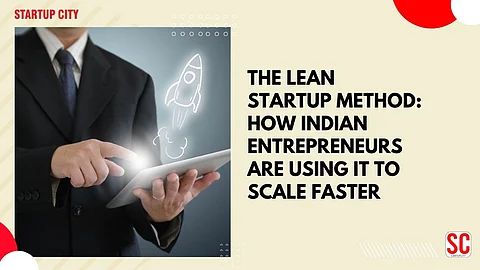

Let me ask you this — have you ever spent months (or even years) perfecting a product, only to realize the market didn’t want it?
If so, you’re not alone.
In fact, that’s the exact pain point the Lean Startup Method was designed to solve — and it's completely changing how Indian startups are building, testing, and scaling today.
In this article, I’m going to show you how some of India’s sharpest founders are using this approach to grow faster, smarter, and leaner — and how you can apply it to your own startup journey.
The Lean Startup Method — popularized by Eric Ries in his bestselling book — is all about building a business that is agile, customer-centric, and data-driven from day one.
“The only way to win is to learn faster than anyone else.” – Eric Ries
In essence, it’s a cycle of Build → Measure → Learn. You start small, release fast, test often, and improve continually — all while keeping your costs low and learning high.
Sounds simple, right? But don’t be fooled.
This method requires discipline, clarity, and a strong feedback loop — which is exactly what makes it so powerful for Indian entrepreneurs facing resource constraints and fast-moving markets.
India's startup ecosystem is booming — we’re talking over 100,000 startups, 100+ unicorns, and a culture of innovation that’s growing by the hour.
But here’s the catch: capital is tighter, competition is fiercer, and customer expectations are sky-high.
That’s why more Indian founders are shifting from traditional, risk-heavy approaches to leaner, smarter execution models.
Let’s explore how.
Instead of waiting months to build a “perfect” product, lean startups are asking:
“What’s the smallest version of this idea we can launch today to start learning from real customers?”
When Dunzo started in Bengaluru, their MVP was a simple WhatsApp group. People sent requests, and the team manually fulfilled them.
No app. No tech stack. Just validation.
Today, Dunzo is one of India’s most recognized hyperlocal delivery platforms — and it all began with a low-tech MVP.
Lesson? Start with what you have. Launch. Learn. Iterate.
One of the key lean startup principles is to validate assumptions with real data, not gut feelings.
Many Indian founders are using:
A/B testing to compare features or pricing
Surveys and interviews to understand user pain points
Analytics tools like Mixpanel, Amplitude, and Google Analytics to track behavior
This helps them cut through the noise and build products customers actually want, not just what they think they want.
Here’s the hard truth: most startups don’t fail from lack of ideas. They fail from running out of cash.
The lean method forces founders to:
Avoid feature bloat
Say no to vanity metrics
Focus only on what moves the needle
This is especially valuable in India, where early-stage funding is competitive and often slow-moving.
In my experience, startups that keep burn low and iterate fast are the ones that survive long enough to thrive.
You don’t launch once — you launch constantly.
Whether it’s product tweaks, messaging tests, or onboarding changes, lean startups are always experimenting.
“In a lean startup, every failure is a data point. Every tweak is an insight.”
Take Razorpay, for example. The fintech giant continuously runs small experiments on its UI/UX, onboarding flow, and pricing — and that relentless optimization is a big part of how they scaled so fast.
At the heart of the lean startup approach is this golden rule:
Talk to your users. Often. Honestly. Relentlessly.
Founders across India are adopting this principle by:
Joining early users on customer calls
Observing behavior rather than guessing intent
Solving real, tangible problems — not hypotheticals
Imagine this: If you spend one hour each day talking to users, in a month, you’ll know more than most competitors will in a year.
Whether you're just starting or looking to pivot, here are some powerful takeaways:
Your goal isn’t to build the perfect product. It’s to build the right product. Validate every step.
Launch early, even if it’s rough. Perfection is a luxury most startups can’t afford.
If a feature or idea isn’t working — let it go. Focus on what your data (and users) are telling you.
Build systems that give you regular insights: dashboards, user surveys, cohort analysis. Data is your compass.
Each failed experiment is a win — if it teaches you something. Keep going.
If the Lean Startup Method resonates with you, here’s what I recommend:
Start small: Build a version of your idea that solves just one clear problem.
Get real feedback: Talk to users. Not friends. Not investors. Real users.
Pivot when needed: Be flexible. Your first idea isn’t your final one.
Keep the loop running: Build → Measure → Learn — repeat endlessly.
The truth is, we’re living in a time where agility beats size, and speed trumps legacy.
The Lean Startup Method isn’t just a trend — it’s a mindset shift. It’s about replacing assumptions with evidence, ego with learning, and delay with action.
If you're building something right now — I salute you. It takes guts. But with the right framework, you can build smarter, scale faster, and fail forward.
So let me leave you with this:
"Start small. Learn fast. Grow fearlessly."
Let’s keep building the future — lean and bold.